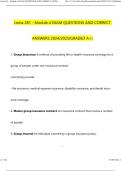CSET Social Science Subtest 2
Questions And Answers With Verified
Solutions 100% Correct!!!
American Revolution (1775-1783) - ANSWER✔✔A period when 13 colonies
gained independence from England. Based on disapproval by colonists of several
taxes and other unpopular laws. Protests lead to fighting in 1775, and after two
main British armies were captured in 1777 and 1781 and an alliance of the
colonists with the French, the Treaty of Paris was signed.
French Revolution (1789) - ANSWER✔✔Reacting to the oppressive aristocracy,
the French middle and lower classes overthrew the king and asserted power for
themselves in a violent and bloody revolution. This uprising was inspired by
America's independence from England and the Enlightenment ideas.
Differences between the French Revolution and American Revolution -
ANSWER✔✔The British colonists were striking back against unwanted taxation
and other sorts of government interference by the British.
The French people were starving and destitute and were striking back against an
autocratic regime that cared more for high fashion and courtly love than bread and
circuses
The American Revolution involved a years long campaign with bloody battles and
skirmishes while the French Revolution was bloody to a degree but mainly an
overthrow of society and its outdated traditions
The American Revolution resulted in a republican government/democracy while
the French revolution resulted in a consulship, a generalship, and an emperor
,Nationalism - ANSWER✔✔Loyalty and devotion to a particular nationality
Industrial Revolution - ANSWER✔✔A period of rapid growth in the use of
machines in manufacturing and production that began in the mid-1700s
began in Great Britain in the 1700s
The industrial nations seized and claimed parts of Africa and Asia in an effort to
control and provide the raw materials needed to feed the industries and machines in
the mother country
a process of change from an agrarian handicraft economy to one dominated by
industry and machine manufacture
new inventions such as the telegraph, railroad, steam boat, spinning jenny, cotton
gin, use of coal as energy
Many people moved to urban cities where factories were built for new jobs and
manufacturing sites were --> led to overcrowding, pollution, and inadequate
sanitation
feature of the IR was working-class movements to demand better work
environments, better benefits, and better pay
Liberalism - ANSWER✔✔A political ideology that emphasizes the civil rights of
citizens, representative government, and the protection of private property. This
ideology, derived from the Enlightenment, was especially popular among the
property-owning middle classes.
,Colonization - ANSWER✔✔The expansion of countries into other countries where
they establish settlements and control the people.
European powers carved up Africa in the search of greater resources and influence
over their neighbors --> they eventually did this to Asian and parts of Central and
South America
Communism - ANSWER✔✔a political theory derived from Karl Marx, advocating
class war and leading to a society in which all property is publicly owned and each
person works and is paid according to their abilities and needs.
Communist states controlled nearly every aspect of society including religion and
economics. The government owned factories and ports, machines and ships. The
income from these goods went to state controlled coffers.
Romanticism - ANSWER✔✔19th century artistic movement that appealed to
emotion rather than reason
Famous Romantic authors included John Keats, William Wordsworth, Victor
Hugo, and Goethe
Realism - ANSWER✔✔A 19th century artistic movement in which writers and
painters sought to show life as it is rather than life as it should be
Famous realists include Dickens, Dostoevsky, Tolstoy, and Twain
Impressionism - ANSWER✔✔An artistic movement that sought to capture a
momentary feel, or impression, of the piece they were drawing
, Famous impressionists include Monet, Degas, van Gogh, Manet, Cezanne, Renoir
Cubism - ANSWER✔✔an early 20th-century style and movement in art,
especially painting, in which perspective with a single viewpoint was abandoned
and use was made of simple geometric shapes, interlocking planes, and, later,
collage.
Famous Cubists include Pablo Picasso
Dadaism - ANSWER✔✔An artistic movement of the 1920s and 1930s that
attacked all accepted standards of art and behavior and delighted in outrageous
conduct.
Pop Art - ANSWER✔✔an American school of the 1950s that imitated the
techniques of commercial art (as the soup cans of Andy Warhol) and the styles of
popular culture and the mass media
Franco-Prussian War - ANSWER✔✔This was a major war between the French
and the Germans in 1871 that brought about the unification of Germany. It was
caused by Otto Von Bismarck altering a telegram from the Prussian King to
provoke the French into attacking Prussia, thus hoping to get the independent
German states to unify with Prussia (which they did, thus creating Germany).
European Imperialism - ANSWER✔✔(19th century) The political and economic
control by European powers of areas in Africa, Asia, and the Pacific.



